SLVS710C January 2007 – February 2017 TPS65050
PRODUCTION DATA.
- 1 Features
- 2 Applications
- 3 Description
- 4 Revision History
- 5 Device Options
- 6 Pin Configuration and Functions
- 7 Specifications
-
8 Detailed Description
- 8.1 Overview
- 8.2 Functional Block Diagrams
- 8.3
Feature Description
- 8.3.1 Operation of DCDC Converters
- 8.3.2 Power-Save Mode
- 8.3.3 Dynamic Voltage Positioning
- 8.3.4 Soft Start
- 8.3.5 100% Duty Cycle Low Dropout Operation
- 8.3.6 Undervoltage Lockout
- 8.3.7 Mode Selection
- 8.3.8 Enable
- 8.3.9 RESET
- 8.3.10 Push-Button ON-OFF (PB-ON-OFF)
- 8.3.11 Short-Circuit Protection
- 8.3.12 Thermal Shutdown
- 8.3.13 Low Dropout Voltage Regulators
- 8.4 Device Functional Modes
-
9 Application and Implementation
- 9.1 Application Information
- 9.2 Typical Application
- 10Power Supply Recommendations
- 11Layout
- 12Device and Documentation Support
- 13Mechanical, Packaging, and Orderable Information
Package Options
Mechanical Data (Package|Pins)
- RSM|32
Thermal pad, mechanical data (Package|Pins)
- RSM|32
Orderable Information
7 Specifications
7.1 Absolute Maximum Ratings
over operating free-air temperature range (unless otherwise noted)(1)| MIN | MAX | UNIT | ||
|---|---|---|---|---|
| VI | Input voltage range on all pins except AGND, PGND, and EN_LDO1 pins with respect to AGND | –0.3 | 7 | V |
| Input voltage range on EN_LDO1 pins with respect to AGND | –0.3 | VCC + 0.5 | V | |
| II | Current at VINDCDC1/2, L1, PGND1, L2, PGND2 | 1800 | mA | |
| Current at all other pins | 1000 | mA | ||
| VO | Output voltage range for LDO1, LDO2, LDO3, and LDO4 | –0.3 | 4 | V |
| Continuous total power dissipation | See Dissipation Ratings | |||
| TA | Operating free-air temperature | –40 | 85 | °C |
| TJ | Maximum junction temperature | 125 | °C | |
| Tstg | Storage temperature | –65 | 150 | °C |
(1) Stresses beyond those listed under Absolute Maximum Ratings may cause permanent damage to the device. These are stress ratings only and functional operation of the device at these or any other conditions beyond those indicated under Recommended Operating Conditions is not implied. Exposure to absolute-maximum-rated conditions for extended periods may affect device reliability.
7.2 ESD Ratings
| VALUE | UNIT | |||
|---|---|---|---|---|
| V(ESD) | Electrostatic discharge | Human body model (HBM), per ANSI/ESDA/JEDEC JS-001(1) | ±2000 | V |
| Charged device model (CDM), per JEDEC specification JESD22-C101(2) | ±1000 | |||
(1) JEDEC document JEP155 states that 500-V HBM allows safe manufacturing with a standard ESD control process.
(2) JEDEC document JEP157 states that 250-V CDM allows safe manufacturing with a standard ESD control process.
7.3 Recommended Operating Conditions
over operating free-air temperature range (unless otherwise noted)| MIN | NOM | MAX | UNIT | ||
|---|---|---|---|---|---|
| VI | Input voltage range for step-down converters, VINDCDC1/2 | 2.5 | 6 | V | |
| VO | Output voltage range for step-down converter, VDCDC1 | 0.6 | VINDCDC1/2 | V | |
| Output voltage range for step-down converter, VDCDC2 | 0.6 | VINDCDC1/2 | V | ||
| VI | Input voltage range for LDOs, VINLDO1, VINLDO2, VINLDO3/4 | 1.5 | 6.5 | V | |
| VO | Output voltage range for LDO1, LDO2, LDO3 and LDO4 | 1 | 3.6 | V | |
| IO | Output current at L1 (DCDC1) for TPS65051, TPS65052 | 1000 | mA | ||
| Output current at L1 (DCDC1) for TPS65050, TPS65054 | 600 | mA | |||
| Output current at L1 (DCDC2) | 600 | mA | |||
| Output current at VLDO1, VLDO2 | 400 | mA | |||
| Output current at VLDO3, VLDO4 | 200 | mA | |||
| Inductor at L1, L2(1) | 1.5 | 2.2 | μH | ||
| CO | Output capacitor at VDCDC1, VDCDC2(1) | 10 | 22 | μF | |
| Output capacitor at VLDO1, VLDO2, VLDO3, VLDO4(1) | 2.2 | μF | |||
| CI | Input capacitor at VCC(1) | 1 | μF | ||
| Input capacitor at VINLDO1/2/3/4(1) | 2.2 | μF | |||
| TA | Operating ambient temperature range | –40 | 85 | °C | |
| TJ | Operating junction temperature range | –40 | 125 | °C | |
| Rfilter | Resistor from battery voltage to VCC used for filtering(2) | 1 | 10 | Ω | |
(1) See the Application and Implementation section of this data sheet for more details.
(2) Up to 2 mA can flow into VCC when both converters are running in PWM, this resistor causes the UVLO threshold to be shifted accordingly.
7.4 Thermal Information
| THERMAL METRIC(1) | TPS6505x | UNIT | |
|---|---|---|---|
| RSM (VQFN) | |||
| 32 PINS | |||
| RθJA | Junction-to-ambient thermal resistance | 37.3 | °C/W |
| RθJC(top) | Junction-to-case (top) thermal resistance | 30.4 | °C/W |
| RθJB | Junction-to-board thermal resistance | 8 | °C/W |
| ψJT | Junction-to-top characterization parameter | 0.4 | °C/W |
| ψJB | Junction-to-board characterization parameter | 7.8 | °C/W |
| RθJC(bot) | Junction-to-case (bottom) thermal resistance | 2.5 | °C/W |
(1) For more information about traditional and new thermal metrics, see the Semiconductor and IC Package Thermal Metrics application report.
7.5 Electrical Characteristics
VCC = VINDCDC1/2 = 3.6 V, EN = VCC, MODE = GND, L = 2.2 μH, CO = 10 μF. TA = -40°C to 85°C, typical values are at TA = 25°C (unless otherwise noted).| PARAMETER | TEST CONDITIONS | MIN | TYP | MAX | UNIT | |||
|---|---|---|---|---|---|---|---|---|
| SUPPLY CURRENT | ||||||||
| VI | Input voltage range at VINDCDC1/2 | 2.5 | 6 | V | ||||
| IQ | Operating quiescent current Total current into VCC, VINDCDC1/2, VINLDO1, VINLDO2, VINLDO3/4 |
One converter, IO = 0 mA. PFM mode enabled (Mode = GND) device not switching, EN_DCDC1 = VI OR EN_DCDC2 = VI; EN_LDO1= EN_LDO2 = EN_LDO3/4 = GND |
20 | 30 | μA | |||
| Two converters, IO = 0 mA PFM mode enabled (Mode = 0) device not switching, EN_DCDC1 = VI AND EN_DCDC2 = VI; EN_LDO1 = EN_LDO2 = EN_LDO3/4 = GND |
32 | 40 | μA | |||||
| One converter, IO = 0 mA. PFM mode enabled (Mode = GND) device not switching, EN_DCDC1 = VI OR EN_DCDC2 = VI; EN_LDO1 = EN_LDO2 = EN_LDO3 = EN_LDO4 = VI |
180 | 250 | μA | |||||
| IQ | Operating quiescent current into VCC | One converter, IO = 0 mA. Switching with no load (Mode = VI), PWM operation EN_DCDC1 = VI OR EN_DCDC2 = VI; EN_LDO1 = EN_LDO2 = EN_LDO3/4 = GND |
0.85 | mA | ||||
| Two converters, IO = 0 mA Switching with no load (Mode = VI), PWM operation EN_DCDC1 = VI AND EN_DCDC2 = VI; EN_LDO1 = EN_LDO2 = EN_LDO3/4 = GND |
1.25 | mA | ||||||
| I(SD) | Shutdown current | EN_DCDC1 = EN_DCDC2 = GND EN_LDO1 = EN_LDO2 = EN_LDO3 = EN_LDO4 = GND | 9 | 12 | μA | |||
| V(UVLO) | Undervoltage lockout threshold for DCDC converters and LDOs | Voltage at VCC | 1.8 | 2 | V | |||
| EN_DCDC1, EN_DCDC2, DEFDCDC2, DEFLDO1, DEFLDO2, DEFLDO3, DEFLDO4, EN_LDO1, EN_LDO2, EN_LDO3, EN_LDO4 | ||||||||
| VIH | High-level input voltage | MODE/DATA, EN_DCDC1, EN_DCDC2, DEFDCDC2, DEFLDO1, DEFLDO2, DEFLDO3, DEFLDO4, EN_LDO1, EN_LDO2, EN_LDO3, EN_LDO4 | 1.2 | VCC | V | |||
| VIL | Low-level input voltage | MODE/DATA, EN_DCDC1, EN_DCDC2, DEFLDO1, DEFLDO2, DEFLDO3, DEFLDO4, EN_LDO1, EN_LDO2, EN_LDO3, EN_LDO4, DEFDCDC2 | 0 | 0.4 | V | |||
| IlB | Input bias current | MODE/DATA = GND or VI
MODE/DATA, EN_DCDC1, EN_DCDC2, DEFDCDC2, DEFLDO1, DEFLDO2, DEFLDO3, DEFLDO4, EN_LDO1, EN_LDO2, EN_LDO3, EN_LDO4 |
0.01 | 1 | μA | |||
| TPS65051 and TPS65052 only V_FB_LDOx = 1 V FB_LDO1, FB_LDO2, FB_LDO3, FB_LDO4 |
100 | nA | ||||||
| POWER SWITCH | ||||||||
| rDS(on) | P-channel MOSFET on resistance | DCDC1 | VINDCDC1/2 = 3.6 V | 280 | 630 | mΩ | ||
| VINDCDC1/2 = 2.5 V | 400 | |||||||
| DCDC2 | VINDCDC1/2 = 3.6 V | 280 | 630 | |||||
| VINDCDC1/2 = 2.5 V | 400 | |||||||
| Ilkg | P-channel leakage current | VDCDCx = V(DS) = 6 V | 1 | μA | ||||
| rDS(on) | N-channel MOSFET on resistance | DCDC1 | VINDCDC1/2 = 3.6 V | 220 | 450 | mΩ | ||
| VINDCDC1/2 = 2.5 V | 320 | |||||||
| DCDC2 | VINDCDC1/2 = 3.6 V | 220 | 450 | |||||
| VINDCDC1/2 = 2.5 V | 320 | |||||||
| Ilkg | N-channel leakage current | VDCDCx = V(DS) = 6 V | 7 | 10 | μA | |||
| I(LIMF) | Forward current limit PMOS (High-Side) and NMOS (Low side) | DCDC1: | TPS65050 TPS65054 |
2.5 V ≤ VINDCDC1/2 ≤ 6 V | 0.85 | 1 | 1.15 | A |
| TPS65051, TPS65052, TPS65056 |
1.19 | 1.4 | 1.65 | |||||
| DCDC2: |
TPS65050 - TPS65056 |
2.5 V ≤ VINDCDC1/2 ≤ 6 V | 0.85 | 1 | 1.15 | A | ||
| Thermal shutdown | Increasing junction temperature | 150 | °C | |||||
| Thermal shutdown hysteresis | Decreasing junction temperature | 20 | °C | |||||
| OSCILLATOR | ||||||||
| fSW | Oscillator frequency | 2.025 | 2.25 | 2.475 | MHz | |||
| OUTPUT | ||||||||
| VO | Output voltage range for DCDC1, DCDC2 | externally adjustable versions | 0.6 | VINDCDC1/2 | V | |||
| Output voltage for DCDC1 | TPS65052 and TPS65056 | 3.3 | V | |||||
| Output voltage for DCDC2 | TPS65052, TPS65054 and TPS65056 | set by DEFDCDC2, see Table 3 | ||||||
| Vref | Reference voltage | externally adjustable versions | 600 | mV | ||||
| VO | DC output voltage accuracy | DCDC1, DCDC2(1) | VINDCDC1/2 = 2.5 V to 6 V 0 mA < IO = < IO(max) Mode = GND, PFM operation |
–2% | 0 | 2% | ||
| VINDCDC1/2 = 2.5 V to 6 V 0 mA < IO = < IO(max) Mode = VI, PWM operation |
–1% | 0 | 1% | |||||
| ΔVO | Power save mode ripple voltage(2) | IO = 1 mA, Mode = GND, VO = 1.3 V, Bandwith = 20 MHz |
25 | mVPP | ||||
| tStart | Start-up time | time from active EN to Start switching | 170 | μs | ||||
| tRamp | VOUT Ramp up Time | time to ramp from 5% to 95% of VO | 750 | μs | ||||
| tRESET_DELAY | RESET delay time | Input voltage at threshold pin rising | 80 | 100 | 120 | ms | ||
| tPB_DB | PB-ONOFF debounce time | 26 | 32 | 38 | ms | |||
| VOL | RESET, PB_OUT output low voltage | IOL = 1 mA, Vhysteresis < 1 V, Vthreshold < 1 V | 0.2 | V | ||||
| IOL | RESET, PB_OUT sink current | 1 | mA | |||||
| Ileak | RESET, PB_OUT output leakage current | After PB_IN has been pulled high once; Vthreshold > 1 V and Vhysteresis > 1 V, VOH = 6 V | 10 | nA | ||||
| Vth | Vthreshold, Vhysteresis threshold | 0.98 | 1 | 1.02 | V | |||
| VLDO1, VLDO2, VLDO3 and VLDO4 Low Dropout Regulators | ||||||||
| VI | Input voltage range for LDO1, LDO2, LDO3, LDO4 | 1.5 | 6.5 | V | ||||
| VO | LDO1 output voltage range | TPS65050, TPS65052 only | 1.2 | 3.3 | V | |||
| LDO2 output voltage range | TPS65050, TPS65052 only | 1.8 | 3.3 | |||||
| LDO3 output voltage range | TPS65050, TPS65052 only | 1.1 | 3.3 | |||||
| LDO4 output voltage range | TPS65050, TPS65052 only | 1.2 | 2.85 | |||||
| V(FB) | Feedback voltage for FB_LDO1, FB_LDO2, FB_LDO3, and FB_LDO4 | TPS65051, TPS65054 and TPS65056 only | 1 | V | ||||
| IO | Maximum output current for LDO1, LDO2 | 400 | mA | |||||
| Maximum output current for LDO3, LDO4 | 200 | mA | ||||||
| I(SC) | LDO1 short-circuit current limit | VLDO1 = GND | 750 | mA | ||||
| LDO2 short-circuit current limit | VLDO2 = GND | 850 | mA | |||||
| LDO3 and LDO4 short-circuit current limit | VLDO3 = GND, VLDO4 = GND | 420 | mA | |||||
| Dropout voltage at LDO1 | IO = 400 mA, VINLDO = 3.4 V | 400 | mV | |||||
| Dropout voltage at LDO2 | IO = 400 mA, VINLDO = 1.8 V | 280 | mV | |||||
| Dropout voltage at LDO3, LDO4 | IO = 200 mA, VINLDO = 1.8 V | 280 | mV | |||||
| Ilkg | Leakage current from VinLDOx to VLDOx | LDO enabled, VINLDO = 6.5 V, VO = 1 V, at TA = 140°C |
3 | μA | ||||
| VO | Output voltage accuracy for LDO1, LDO2, LDO3, LDO4 | IO = 10 mA | –2% | 1% | ||||
| Line regulation for LDO1, LDO2, LDO3, LDO4 | VINLDO1,2 = VLDO1,2 + 0.5 V (min. 2.5 V) to 6.5V, VINLDO3,4 = VLDO3,4 + 0.5 V (minimum 2.5 V) to 6.5 V, IO = 10 mA |
–1% | 1% | |||||
| Load regulation for LDO1, LDO2, LDO3, LDO4 | IO = 0 mA to 400 mA for LDO1, LDO2 IO = 0 mA to 200 mA for LDO3, LDO4 |
–1% | 1% | |||||
| Regulation time for LDO1, LDO2, LDO3, LDO4 | Load change from 10% to 90% | 10 | μs | |||||
| PSRR | Power supply rejection ratio | f = 10 kHz; IO = 50 mA; VI = VO + 1 V | 70 | dB | ||||
| R(DIS) | Internal discharge resistor at VLDO1, VLDO2, VLDO3, VLDO4 | active when LDO is disabled | 350 | R | ||||
| Thermal shutdown | Increasing junction temperature | 140 | °C | |||||
| Thermal shutdown hysteresis | Decreasing junction temperature | 20 | °C | |||||
(1) Output voltage specification does not include tolerance of external voltage programming resistors.
(2) In Power Save Mode, operation is typically entered at IPSM = VI / 32 Ω.
7.6 Dissipation Ratings
| PACKAGE | RθJA (1) | POWER RATING TA ≤ 25°C |
DERATING FACTOR ABOVE TA = 25°C |
POWER RATING TA = 70°C |
POWER RATING TA = 85°C |
|---|---|---|---|---|---|
| RSM | 58 K/W | 1.7 W | 17 mW/K | 0.95 W | 0.68 W |
(1) The thermal resistance junction to case of the RSM package is 4 K/W measured on a high K board
7.7 Typical Characteristics
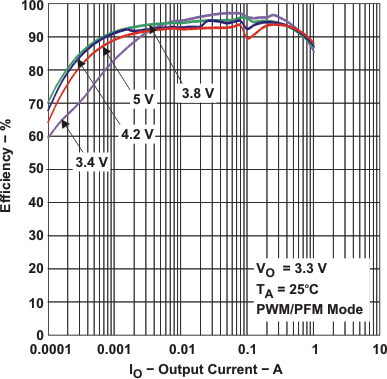 Figure 1. Efficiency vs Output Current
Figure 1. Efficiency vs Output Current
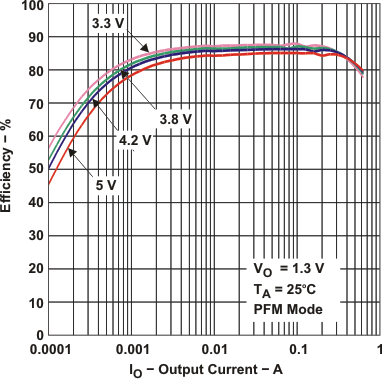 Figure 3. Efficiency vs Output Current
Figure 3. Efficiency vs Output Current
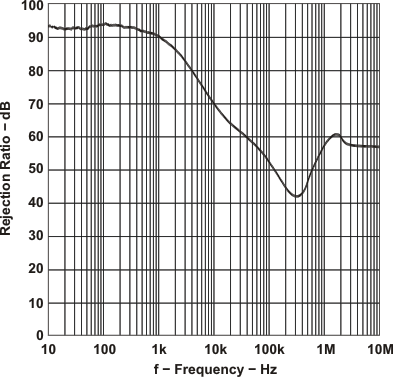 Figure 5. Power Supply Rejection Ratio vs Frequency
Figure 5. Power Supply Rejection Ratio vs Frequency
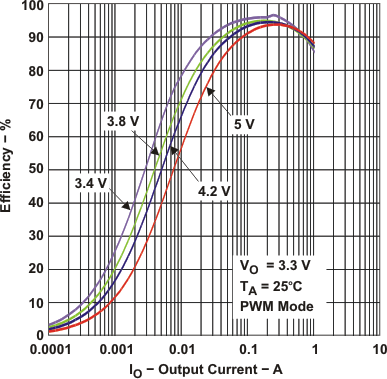 Figure 2. Efficiency vs Output Current
Figure 2. Efficiency vs Output Current
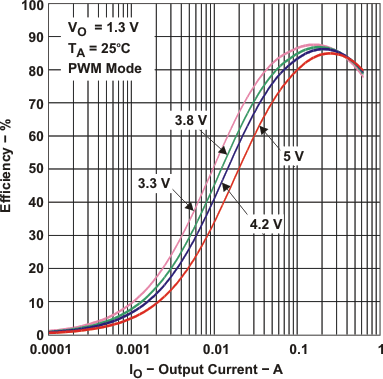 Figure 4. Efficiency vs Output Current
Figure 4. Efficiency vs Output Current